
How to Use ZMPT101B: Examples, Pinouts, and Specs
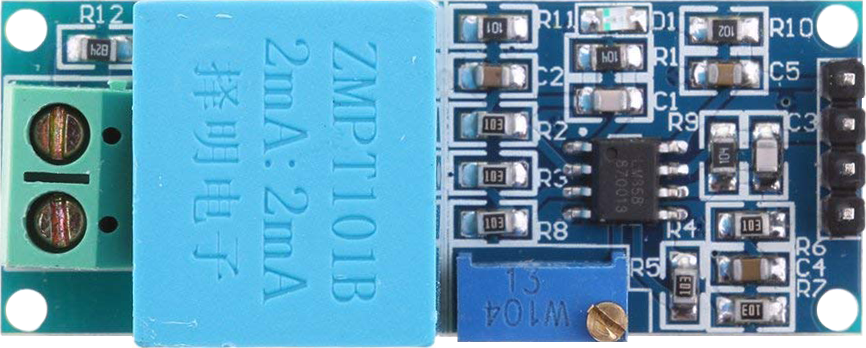
 Design with ZMPT101B in Cirkit Designer
Design with ZMPT101B in Cirkit DesignerIntroduction
The ZMPT101B is a precision voltage transformer designed for measuring AC voltage. It provides an isolated output proportional to the input voltage, ensuring safety and accuracy in voltage measurement applications. This component is widely used in power monitoring, energy metering, and other applications requiring precise AC voltage measurement. Its compact size and high accuracy make it a popular choice for both industrial and hobbyist projects.
Explore Projects Built with ZMPT101B
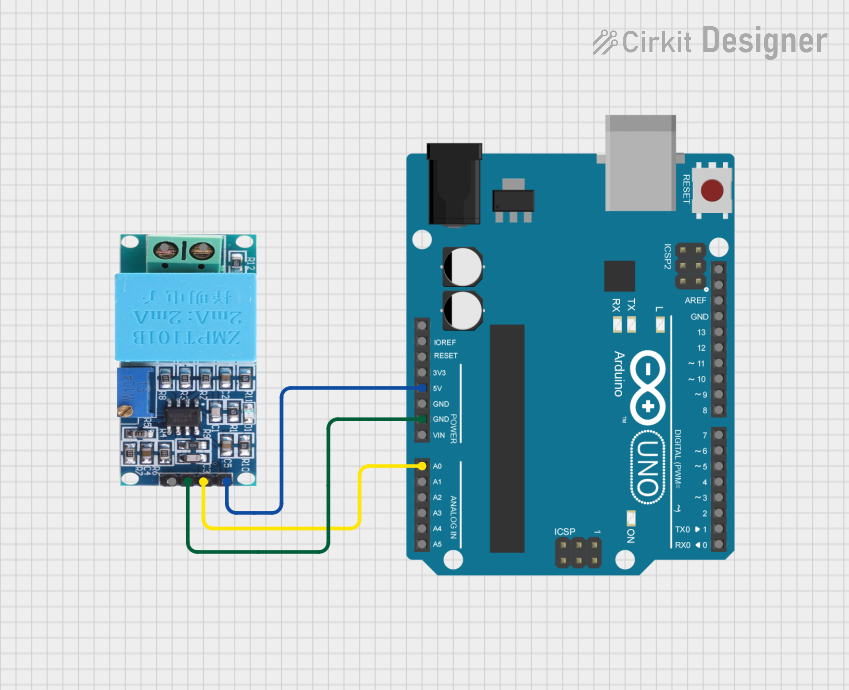
 Open Project in Cirkit Designer
Open Project in Cirkit Designer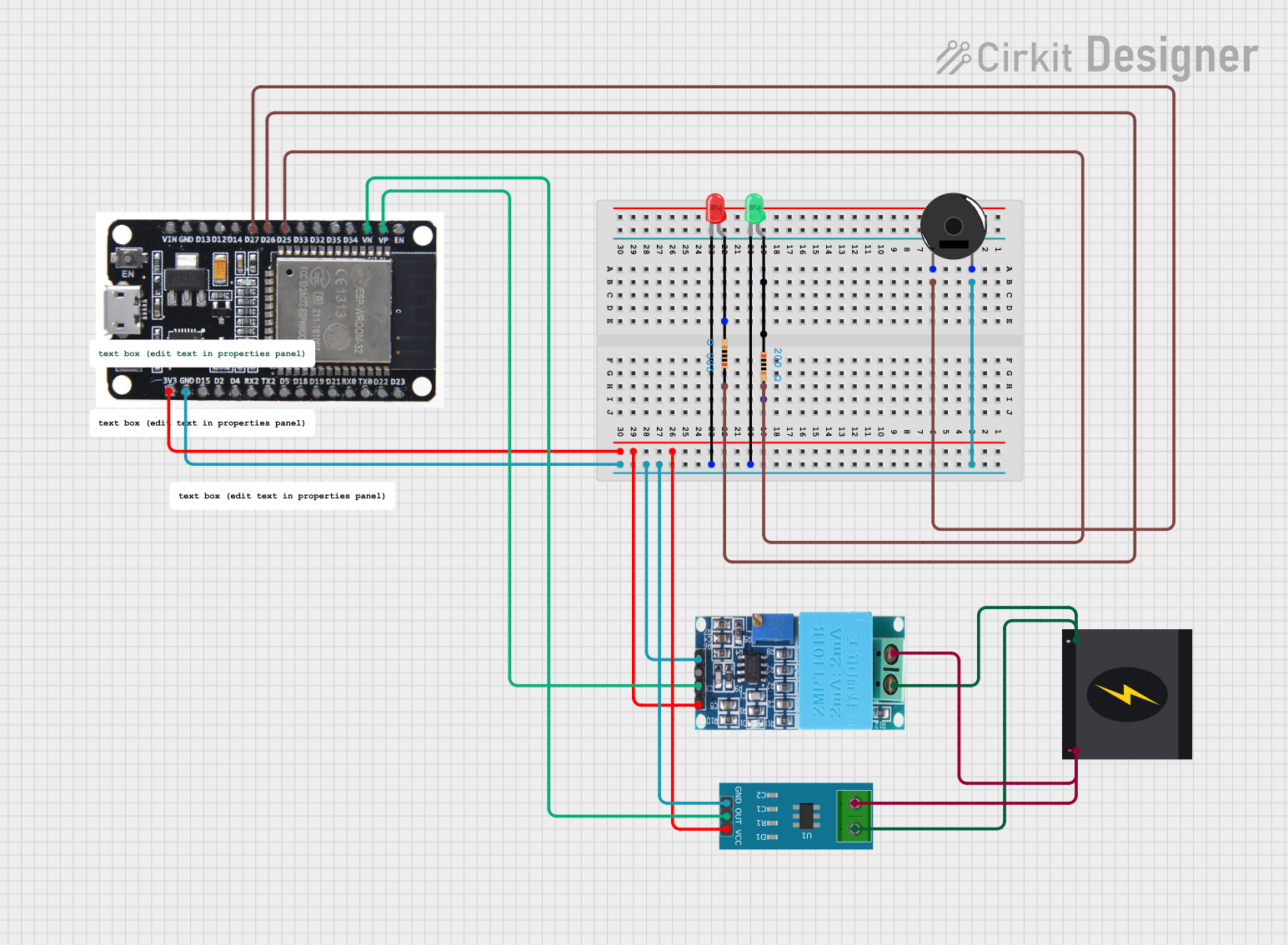
 Open Project in Cirkit Designer
Open Project in Cirkit Designer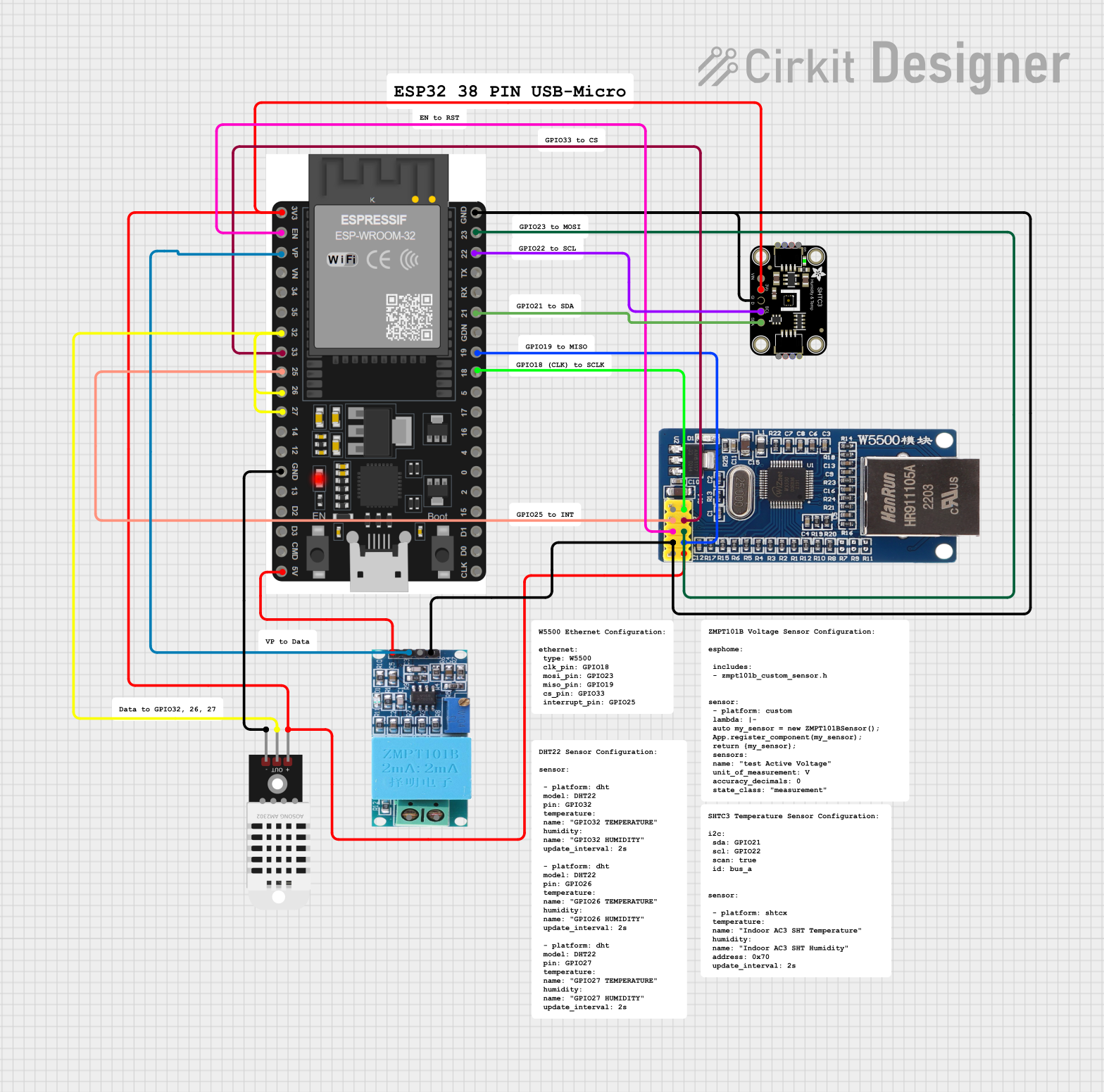
 Open Project in Cirkit Designer
Open Project in Cirkit Designer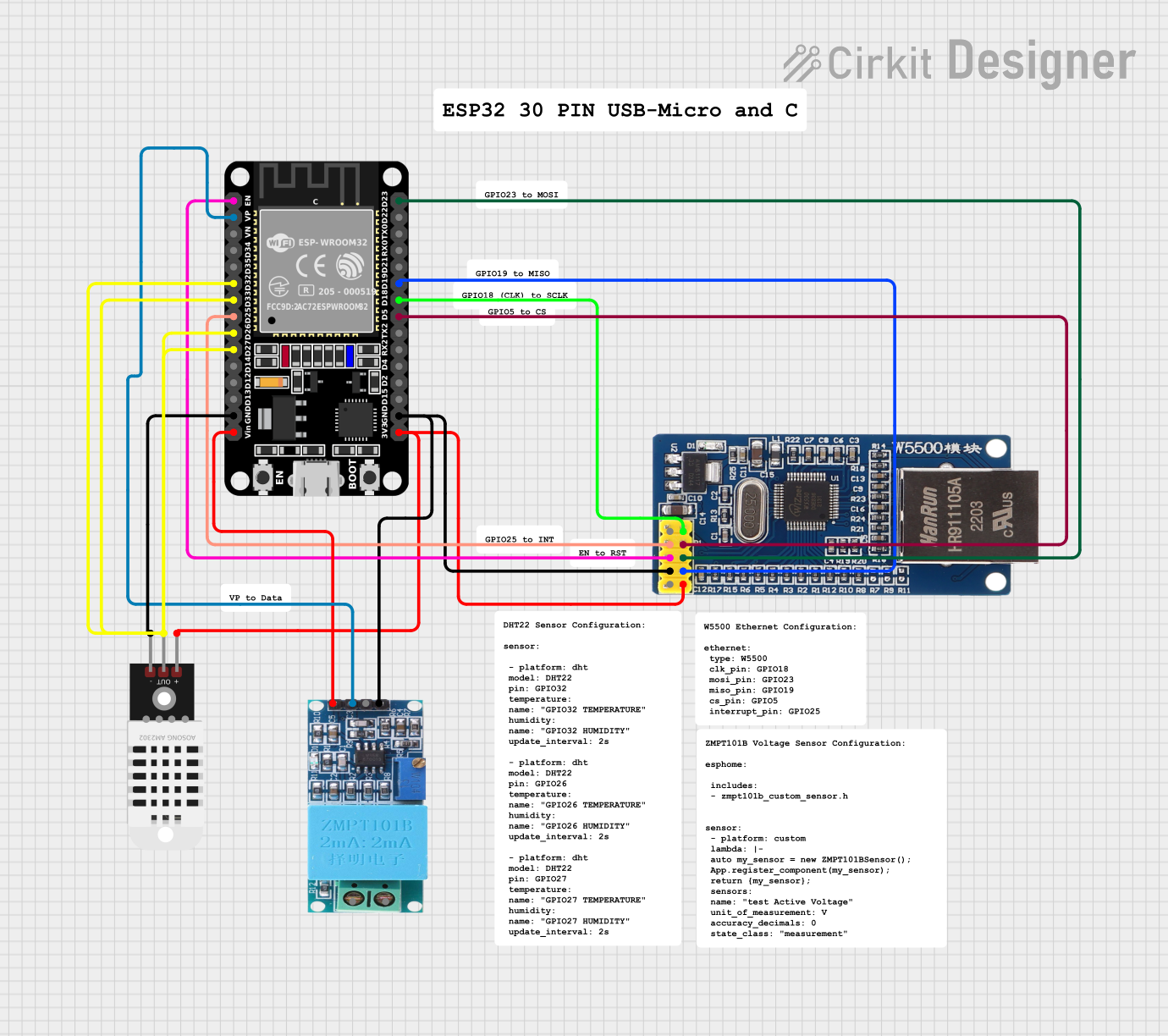
 Open Project in Cirkit Designer
Open Project in Cirkit DesignerExplore Projects Built with ZMPT101B

 Open Project in Cirkit Designer
Open Project in Cirkit Designer
 Open Project in Cirkit Designer
Open Project in Cirkit Designer
 Open Project in Cirkit Designer
Open Project in Cirkit Designer
 Open Project in Cirkit Designer
Open Project in Cirkit DesignerCommon Applications
- Power monitoring systems
- Energy metering devices
- AC voltage measurement in IoT projects
- Home automation systems
- Electrical safety monitoring
Technical Specifications
The ZMPT101B is designed to provide reliable and accurate voltage measurement. Below are its key technical details:
| Parameter | Value |
|---|---|
| Input Voltage Range | 0–250V AC (with appropriate scaling) |
| Output Voltage Range | Proportional to input (isolated) |
| Accuracy | High precision |
| Operating Temperature | -40°C to +70°C |
| Dimensions | 18mm x 18mm x 20mm |
| Isolation Voltage | 2kV |
| Frequency Range | 50Hz–60Hz |
Pin Configuration and Descriptions
The ZMPT101B module typically comes with a built-in operational amplifier circuit for signal conditioning. Below is the pin configuration for the module:
| Pin | Name | Description |
|---|---|---|
| 1 | VCC | Power supply input (typically 5V DC) |
| 2 | GND | Ground connection |
| 3 | Signal Output | Analog output voltage proportional to the measured AC voltage |
| 4 | AC Input (L) | Live wire connection for AC voltage input |
| 5 | AC Input (N) | Neutral wire connection for AC voltage input |
Usage Instructions
The ZMPT101B is straightforward to use in a circuit. Below are the steps and considerations for integrating it into your project:
How to Use the ZMPT101B
- Power the Module: Connect the VCC pin to a 5V DC power supply and the GND pin to the ground.
- Connect the AC Voltage Source: Attach the live (L) and neutral (N) wires of the AC voltage source to the respective input terminals of the ZMPT101B.
- Read the Output Signal: The Signal Output pin provides an analog voltage proportional to the input AC voltage. This can be read using an ADC (Analog-to-Digital Converter) on a microcontroller like an Arduino.
Important Considerations
- Scaling the Input Voltage: The ZMPT101B is designed for high-voltage AC measurement. Ensure that the input voltage does not exceed the module's rated range.
- Calibration: For accurate measurements, calibrate the module by comparing its output with a known reference voltage.
- Isolation: The ZMPT101B provides electrical isolation between the input and output, enhancing safety. However, always handle high-voltage connections with care.
- Filtering: Use a low-pass filter on the output signal to reduce noise and improve measurement stability.
Example: Connecting ZMPT101B to Arduino UNO
Below is an example of how to connect the ZMPT101B to an Arduino UNO and read the AC voltage:
Circuit Connections
- Connect the ZMPT101B's VCC pin to the Arduino's 5V pin.
- Connect the GND pin to the Arduino's GND.
- Connect the Signal Output pin to an analog input pin on the Arduino (e.g., A0).
- Connect the AC voltage source to the ZMPT101B's AC input terminals (L and N).
Arduino Code
// ZMPT101B AC Voltage Measurement Example
// Connect the Signal Output pin to Arduino A0
// Ensure proper calibration for accurate voltage readings
const int sensorPin = A0; // Analog pin connected to ZMPT101B output
float calibrationFactor = 100.0; // Adjust this value based on calibration
void setup() {
Serial.begin(9600); // Initialize serial communication
}
void loop() {
int sensorValue = analogRead(sensorPin); // Read analog value from ZMPT101B
float voltage = (sensorValue / 1023.0) * 5.0; // Convert to voltage (0-5V)
// Calculate AC voltage using calibration factor
float acVoltage = voltage * calibrationFactor;
// Print the measured AC voltage
Serial.print("AC Voltage: ");
Serial.print(acVoltage);
Serial.println(" V");
delay(1000); // Wait for 1 second before next reading
}
Best Practices
- Always calibrate the module before use to ensure accurate readings.
- Use proper insulation and safety precautions when working with high-voltage AC inputs.
- Avoid placing the module near sources of electromagnetic interference (EMI) to maintain signal integrity.
Troubleshooting and FAQs
Common Issues and Solutions
No Output Signal
- Cause: Incorrect wiring or no AC input.
- Solution: Double-check all connections and ensure the AC input is properly connected.
Inaccurate Voltage Readings
- Cause: Module not calibrated or noisy signal.
- Solution: Perform calibration using a known reference voltage. Add a low-pass filter to reduce noise.
Output Signal Too Weak
- Cause: Low input voltage or incorrect scaling factor.
- Solution: Verify the input voltage and adjust the calibration factor in your code.
Module Overheating
- Cause: Input voltage exceeds the rated range.
- Solution: Ensure the input voltage is within the module's specified range.
FAQs
Q: Can the ZMPT101B measure DC voltage?
A: No, the ZMPT101B is designed specifically for AC voltage measurement.
Q: How do I calibrate the ZMPT101B?
A: Use a known AC voltage source and adjust the calibration factor in your code until the output matches the reference voltage.
Q: Is the ZMPT101B safe to use with high-voltage inputs?
A: Yes, the ZMPT101B provides electrical isolation, but always follow proper safety precautions when working with high-voltage circuits.
Q: Can I use the ZMPT101B with a 3.3V microcontroller?
A: Yes, but ensure the output signal is within the ADC range of your microcontroller. You may need to adjust the circuit or use a level shifter.